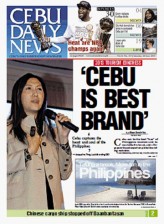
“A city like Cebu, I always felt, was the only way to brand the Philippines,” said Lexis Branding chief executive officer Jacqueline Thng at the 2013 Tourism Congress in Cebu City.
She said it was the single place that “captures the heart and soul” of the country.
“You have all the natural, beautiful palces to see here – you can’t get that in Manila… Cebu can represent all of the Philippines,” she said.
Her comment drew applause in the ballroom of the Marco Polo Plaza filled with tourism stakeholders from the private sector and government, including students from Cebu universities in an event mounted by the Cebu Chamber of Commerce and Industry for Cebu Business Month.
Thng discussed the impact of branding, which she said is about “identity” and is also “based on how people see you”.
Noting the perception of many visitors who view the Philipines as a security risk, Thng said it would easier to promote Cebu than reverse this negative image.
“To change the perception of the Philippines is a lot harder because of what has happened over the years in the media than to use Cebu as a platform to change the image of the Philppines,” she said.
She said Cebu would be a “very good face “of the country with its combination of beaches and urban comforts.
But she said to deliver the promise of of “More Fun in the Philippines” requires a “consistent” experience from the time a tourist arrives at the airport to the roads, restaurants and scenes along the way to the destination.
Country branding is a major exercise, she said, and requires a wholistic approach, major investment in infrastruture, and cooperation of the people, government and other stakeholders.
ICONS
Top tourist destinations like Italy, Paris and New York are strong brands, she said, and are instantly associated with icons like the Colloseum in Rome, the Eiffel Tower in Paris and the Statue of Liberty in the US.
Asked in an open forum what would be Cebu’s icon, she suggested lightheartedly the “lechon” or roasted pig, because that’s what she noticed friends in Manila always asking for when they would visit Cebu.
But Thng cautioned that more detailed research and stakeholder planning goes into the process of identifiying and developing a country’s brand.
Part of her presentation was a video of the branding of New Zealand as the “youngest country” in the world associated with the pop song “Forever Young”.
Thng, whose company has taken part in the branding of global entities like Vertu, China Airlines and Shangri-la Resorts, said she considers herself “half-Pinoy” after coming back and forth over the past five years to attend to Philippine clients. They include Goldilocks, Penshoppe and the Belo Medical Group.
She said she tells her friends it is “extremely safe” in the Philippines and that “I feel just as safe walking in the streets here as in Singapore.”
The Departmetn of Tourism slogan “More Fun in the Philippines” is already a hit with over 5,000 versions of it spontaneously created by fans.
BE CONSISTENT
But Thng reminded that branding “goes beyond advertising” and should be a consistent message over the long term.
Changing it every two years “will only create confusion,” she said in reaction to tour operator Alice Queblatin’s query about the DOT’s practice of changing its slogan every two or three years when a new administration comes in.
“Branding is something not only for today or short term but for many years to come. Find what you think is meaningful, put in a roadmap and grow it. It’s all about consistency,” said Thng.
She said that Cebu and the Philippines has a huge potential that hasn’t been full tapped.
Thng said Cebu will need a working committee to sit down and define what Cebu really is about, and the perceptions of Cebu that people want to amplify or change.
She said it’s important to listen to both the “internal voice” of the local population and “external voice”, referring to demands of tourists or the market.
“The voice of Cebuanos must be considered” because it is the people who will deliver the experience, she said.
“Understand how the world is seeing you, and what you can change.”With Eileen G. Mangubat